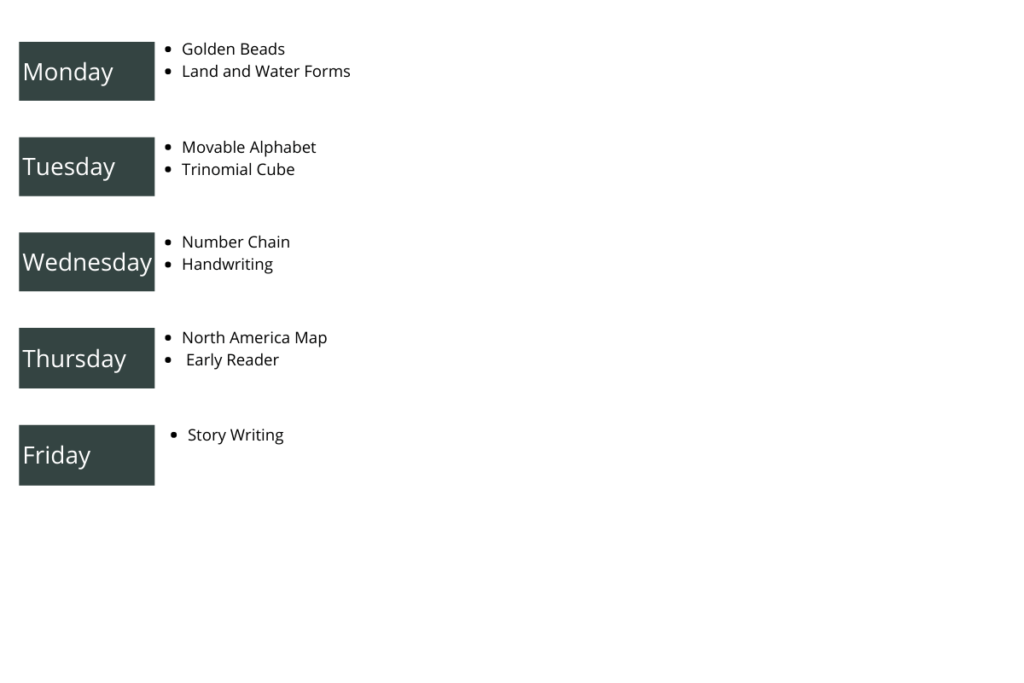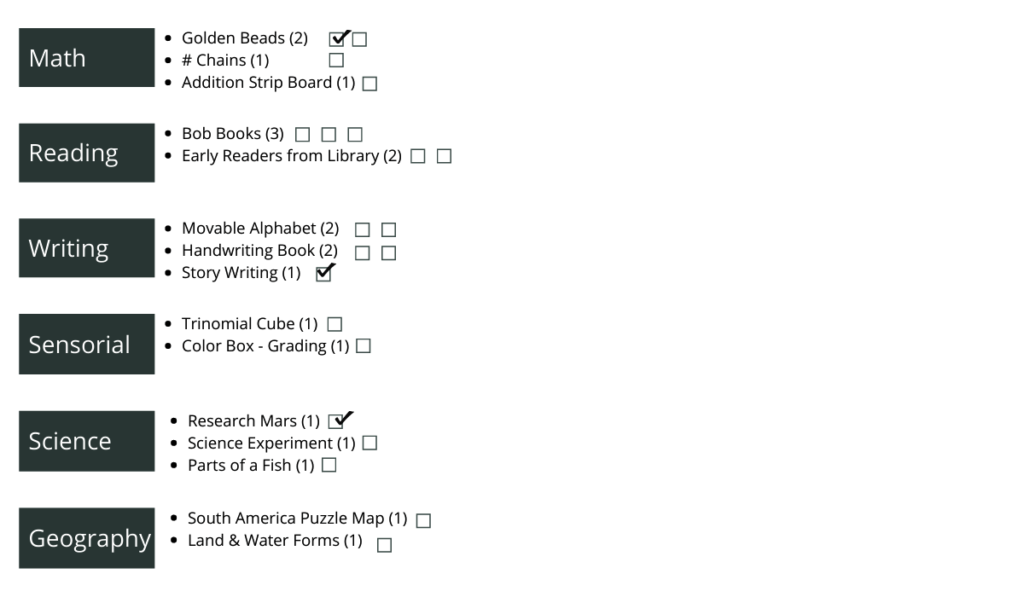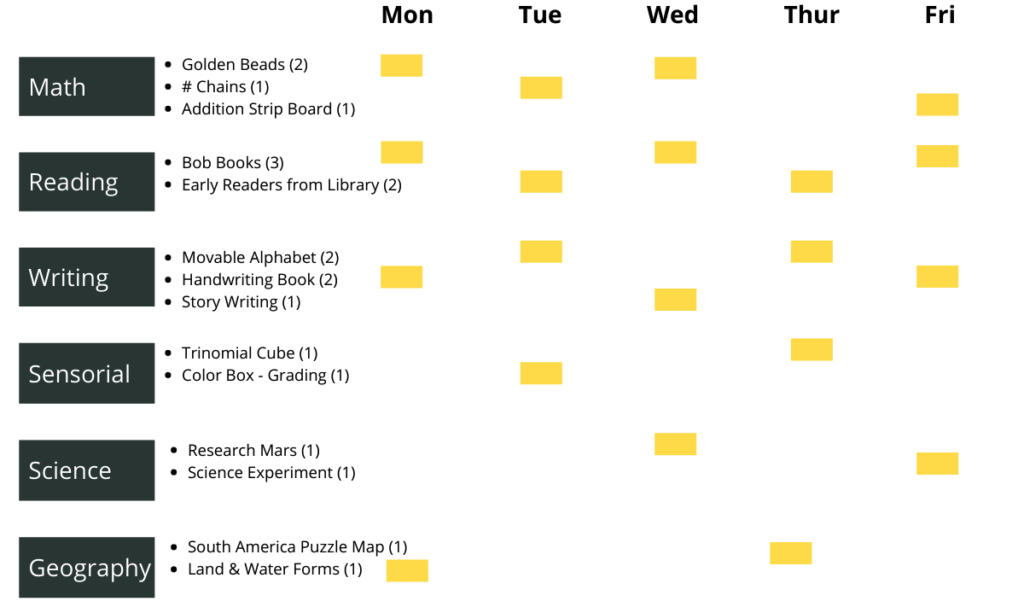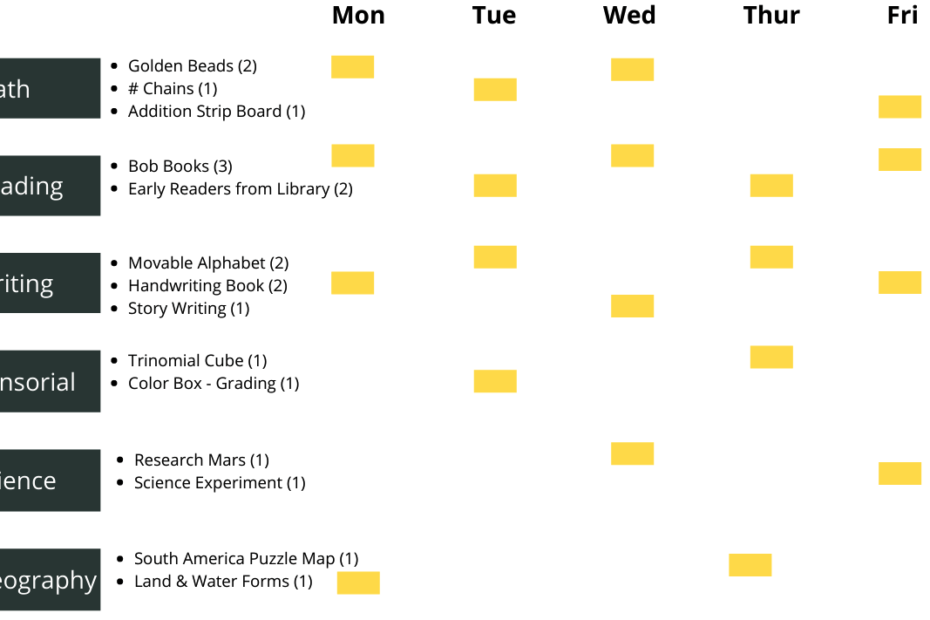Setting goals with kids is a great exercise, whether you homeschool or just want to help them learn this valuable life skill.
One of the first things parents notice when visiting a Montessori classroom for the first time is the independence children have in choosing what to work on.
Instead of the teacher dictating that all children will now practice addition, each child chooses work from the shelves. They may begin with addition or they may begin with reading or painting at the easel.
Some parents love this idea but others wonder if their child will simply draw all day and never learn to read or to multiply.
There are many ways Montessori teachers encourage children to choose challenging work. One of the simplest, yet most effective, is to remember that children actually like a good challenge, as long as they’re ready for it. Children have a beautiful and innate desire to learn and that comes from facing a challenge of just the right difficulty.
The catch is, if we nag children too much about doing something, it becomes work instead of play, it becomes obligation instead of choice. I think perhaps Mark Twain said it best in Tom Sawyer:
“Work consists of whatever a body is obliged to do, and play consists of whatever a body is not obliged to do. And this would help him to understand why constructing artificial flowers or performing on a tread-mill is work, while rolling ten-pins or climbing Mont Blanc is only amusement. There are wealthy gentlemen in England who drive four-horse passenger-coaches twenty or thirty miles on a daily line, in the summer, because the privilege costs them considerable money; but if they were offered wages for the service, that would turn it into work and then they would resign.“
This is, in essence, why offering smiley stickers and other rewards does not motivate children in the long run. It turns something that could be fun and exciting into something children must be paid for, into work.
Yet, despite this pesky aspect of human nature, some children need a bit of encouragement to regularly practice math or do the hard work of learning to sound out words that will later lead to such joy in reading.
This is when goal setting with kids can come in really handy. Creating a Montessori work plan with your child helps them set goals for the week.
Tips on Setting Goals with Kids
What is a Montessori Work Plan
As you likely know from setting your own goals, it helps to make them actionable and specific, and it helps to write them down. This is why a work plan is helpful, either in a Montessori classroom or when doing Montessori at home.
A work plan outlines a child’s goals for the week. Not requirements, not minimum expectations, but goals to work toward.
You can make the work plan as general or as specific as you like. You might set goals for how many pieces of math work and how many pieces of language work a child does each week. Or, you might set goals for how many books a child reads aloud, how many times they practice movable alphabet, and how many times they do golden beads.
Experiment and do what works for your child!
You can find many beautiful, pre-made Montessori work plans online and there is nothing wrong with that. However, I strongly recommend making your own simple work plan with your child, at least to start. This allows your child to be a part of the process, to make goals for themselves, rather than having them handed down.
This may seem like a minor difference but when it comes to mindset, it’s pretty significant. Think of it as the difference between setting a goal for yourself that you really want to accomplish, perhaps learning to knit or writing a book, and having a quota handed down to you that must fulfill.
An ideal Montessori work plan is child-led. The child helps create it and the child tracks their work as they complete it.
The Goal Setting Process – Do it Together!
So if the work plan is child-led, what if they simply write “draw 8 pictures” or “read 5 books” and don’t include any math?
First of all, most children won’t do that. Just like adults, children like setting aspirational goals for themselves. They like setting a goal and working toward it.
Furthermore, you don’t need to let your child create their work plan all on their own. Work on it together, make it collaborative.
I recommend having a simple folder with a blank page for each week. At the start of each week, sit together and make some goals.
Look at the previous week’s goals and see what worked well and what didn’t. Were the goals too easy? Did your child accomplish them all by Tuesday? Then make them more challenging!
On the flip side, were the goals much too hard? Was your child nowhere near meeting them at the end of the week? In that case, make them easier.
And feel free to set certain parameters. You might write each area of the classroom or curriculum on the work plan and let your child fill in the specific work within each area they want to practice. You might write down each piece of work you’d like your child to practice and let them choose how many times.
Gently encourage your child to challenge themselves, while keeping it child-led. Don’t feel the need to reward them for meeting their week’s goals – meeting a goal is a reward in and of itself! Don’t feel the need to punish a child for not meeting their goals. They can try again next week or adjust the goals as needed.
I’ve seen this work quite well in the classroom but this is a process I’m just beginning with my own son. He’s recently turned five and is ready for a bit more structure and challenge around his school work. I’m excited to track his progress over time and to see what kind of goals he sets for himself.
Sample Work Plans
Here are a few examples if you need help getting started! Don’t be afraid to keep it really simple.
In this first version, simply make a list of the days of the week and ask your child to choose one or two pieces of work they want to accomplish each day. They’ll of course do other things as well but this is a great exercise in learning to prioritize. Having a plan can also help jumpstart the day if you have a child who is reluctant to get started.

Alternatively, you and your child can list some things they want to accomplish in the coming week. They can then choose something from the list to start with each day.

After your child has had some practice with work planning, you can also invite them to highlight what they want to accomplish each day of the week.

Don’t be intimidated by the concept of a work plan! It really can be as simple as a handwritten list of goals each week. Let the process evolve as your child grows and keep things flexible.
I would love to hear how you plan and structure work with your children in the comments below!
